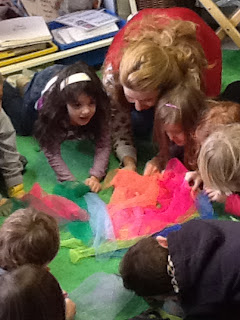We have often made wood sculptures in our art center, but the idea for drawing the sculptures when completed came from this wonderful book. Drawing real items is important for children to learn, as scientific drawing is an important piece of project work when young children engage in fieldwork. Learning to draw what you see is just as valuable as learning to draw creatively. Both are important activities, and opportunities to do both should be provided in the learning environments of our young children.
Discount School Supply sells a great box of wood bits and pieces for around $18. It is always different and the children LOVE to explore the various shapes and sizes. I gathered the large bases from wood I had around my house, but often parents are happy to run to the local hardware store or lumber yard to ask for free scraps of wood. That is how we stock our workbench. (and FYI to my class parents...we are out of wood :-)
We put out bowls of wood glue and paint brushes.
When the glue was dry, on another day, we put our liquid watercolor paint and they painted them. This water color paint gives the wood a stained look, so you can still see the details of the wood.
On yet another day, the children took their dry sculptures and drew them. First we did have a group lesson and talked about drawing what we really see, the various shapes of the wood pieces, how what we see changes depending on how we look at it, how to get started, etc.
It was really interesting to see how each child approached the task and the various perspectives of the sculptures.
We gave them plain white paper and a black marker. We did use markers for this one activity as the fine point lent itself well to the fine lines of their drawings. (See post on crayons vs. markers)
We displayed the drawings behind the sculptures. When I went to hang them, I could tell which way to face the sculptures based on the details the children were able to capture.
I encourage you to give it a try with your students and to get your hands on that book!! Perhaps a holiday gift to your classroom.

















































